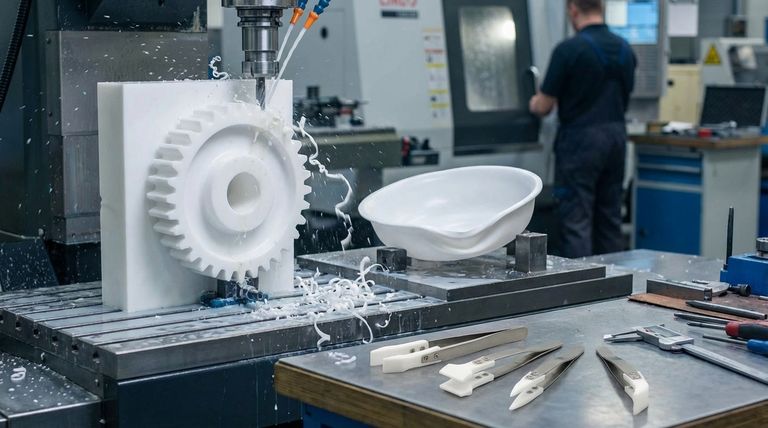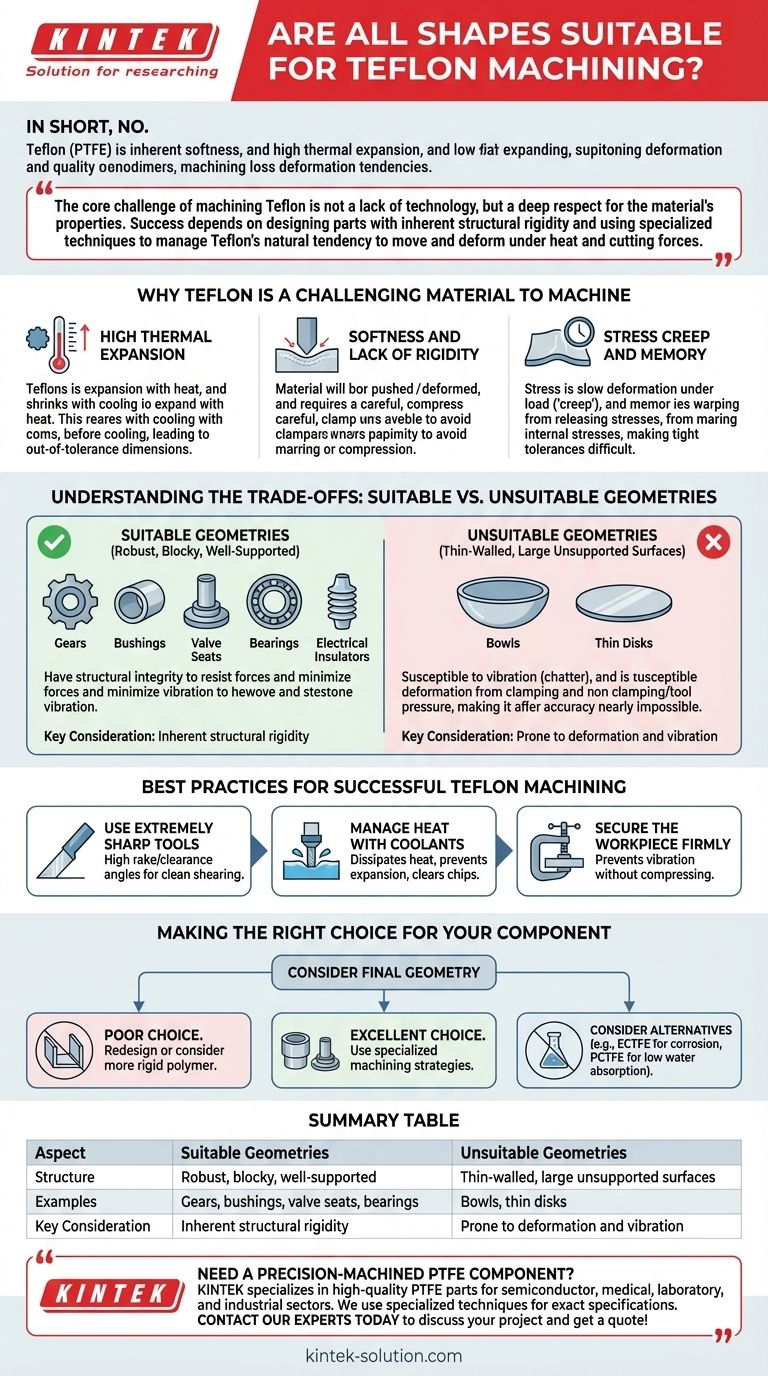In short, no. Not all shapes are suitable for Teflon (PTFE) machining. While valued for its unique properties, Teflon's inherent softness, high thermal expansion, and tendency to deform under pressure make certain geometries extremely difficult to produce accurately. Shapes with thin walls or large, unsupported surfaces, such as bowls or thin disks, are particularly challenging.
The core challenge of machining Teflon is not a lack of technology, but a deep respect for the material's properties. Success depends on designing parts with inherent structural rigidity and using specialized techniques to manage Teflon's natural tendency to move and deform under heat and cutting forces.

Why Teflon is a Challenging Material to Machine
Teflon's most desirable qualities—its low friction and chemical inertness—are directly linked to the physical properties that make it difficult to machine with high precision.
High Thermal Expansion
Teflon expands and contracts significantly with temperature changes. The friction from a cutting tool generates localized heat, causing the material to expand during the cut and shrink as it cools, often resulting in dimensions that are out of tolerance.
Softness and Lack of Rigidity
Unlike metals or even more rigid plastics, Teflon is exceptionally soft. This means it can easily be pushed away or deformed by the cutting tool rather than being cleanly sheared. It also requires careful clamping to avoid marring the surface or compressing the part, which leads to inaccurate final dimensions.
Stress Creep and Memory
PTFE has a tendency to "creep," meaning it will slowly deform when under a constant load, such as from a clamp. It also possesses a "memory" of its original extruded or molded shape, and machining can release internal stresses, causing the part to warp over time. This makes holding very tight tolerances a significant challenge.
Understanding the Trade-offs: Suitable vs. Unsuitable Geometries
The key is to design components that work with the material's nature, not against it.
Geometries That Work Well
Robust, blocky, and well-supported shapes are ideal for Teflon. These geometries have the structural integrity to resist cutting forces and minimize vibration.
Common successful applications include gears, bushings, fittings, valve seats, bearings, and electrical insulators. These parts typically have thicker walls and a solid structure that can be securely fixtured.
Geometries to Avoid
Shapes that lack inherent rigidity are poor candidates for precision Teflon machining. Thin-walled, bowl-like structures or large, flat disks are prime examples.
These shapes are highly susceptible to vibration (chatter), which ruins the surface finish. Furthermore, their lack of support makes them prone to deforming from both clamping and tool pressure, making accuracy nearly impossible to achieve.
Best Practices for Successful Teflon Machining
For suitable geometries, machinists employ specific strategies to counteract the material's difficult properties.
Use Extremely Sharp Tools
Dull tools will push and tear the material instead of cutting it. Extremely sharp, purpose-built tools with high rake and clearance angles are necessary to create a clean shearing action.
Manage Heat with Coolants
Flooding the workpiece with coolant is critical. This practice serves two purposes: it dissipates heat to prevent thermal expansion and helps to clear away the stringy chips that Teflon produces.
Secure the Workpiece Firmly
Proper clamping is essential to prevent vibration. This must be done carefully to hold the part securely without compressing it, which would lead to dimensional errors once the pressure is released.
Making the Right Choice for Your Component
To determine if Teflon is the right material, consider the final geometry of your part.
- If your primary focus is a complex shape with thin walls: Teflon is likely a poor choice, and you should consider a more rigid polymer or redesigning the part for manufacturability.
- If your primary focus is a robust component like a bushing or valve seat: Teflon is an excellent choice, provided the correct machining strategies are employed to ensure precision.
- If your primary focus is chemical resistance but Teflon's properties are problematic: Consider alternatives like ECTFE for superior corrosion resistance or PCTFE for extremely low water absorption.
Understanding these material properties empowers you to design parts that leverage Teflon's strengths while avoiding its inherent machining pitfalls.
Summary Table:
| Aspect | Suitable Geometries | Unsuitable Geometries |
|---|---|---|
| Structure | Robust, blocky, well-supported | Thin-walled, large unsupported surfaces |
| Examples | Gears, bushings, valve seats, bearings | Bowls, thin disks |
| Key Consideration | Inherent structural rigidity | Prone to deformation and vibration |
Need a precision-machined PTFE component?
KINTEK specializes in manufacturing high-quality PTFE parts (seals, liners, labware, and more) for the semiconductor, medical, laboratory, and industrial sectors. We understand the unique challenges of Teflon machining and use specialized techniques to ensure your parts meet exact specifications, from prototypes to high-volume production.
Contact our experts today to discuss your project and get a quote!
Visual Guide

Related Products
- Custom PTFE Parts Manufacturer for Teflon Parts and PTFE Tweezers
- Custom PTFE Parts Manufacturer for Teflon Containers and Components
- Custom PTFE Teflon Balls for Advanced Industrial Applications
- Custom PTFE Volumetric Flasks for Advanced Scientific and Industrial Use
- Customizable PTFE Rods for Advanced Industrial Applications
People Also Ask
- What finishing techniques are effective for machined Teflon parts? Achieve Functional Performance and Dimensional Stability
- What are the unique properties of PTFE? The 3 Pillars Driving Demand for High-Performance Parts
- What chemical processing applications involve PTFE-machined parts? Essential Components for Corrosive & High-Purity Systems
- What industrial benefits do PTFE-machined parts offer? Achieve Peak Performance in Demanding Applications
- What design considerations are important for custom PTFE parts? Design for Performance & Reliability



















